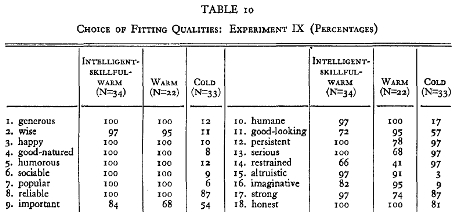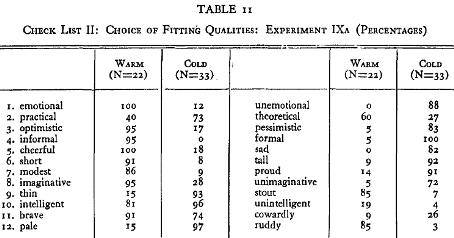To a marked degree the impressions here examined possess a strongly unified character. At the same time they lack the nuances and discriminations that a full-fledged understanding of another person provides. Therefore they can be easily dominated by a single direction. We propose now to observe in a more direct and extreme manner the formation of a global impression.
Experiment IX
We select from the series of Experiment I three terms: intelligent – skillful – warm - all referring to-strong positive characteristics. These form the basis of judgment. The results appear in Table 10.
There develops a one-directed impression, far stronger than any observed in the preceding experiments. The written sketches, too, are unanimously enthusiastic. The impression also develops effortlessly. Negative characteristics hardly intrude. That this fails to happen raises a problem. Many negative qualities could quite understandably be living together with those given. But the subjects do not as a rule complete them in this direction. This, indeed, they seem to avoid.
The next step was to observe an impression based on a single trait. There are two groups; one group is instructed to select from the check list those characteristics which belong to a "warm" person, the second group those belonging to a "cold" person. The results appear in Table 10.
In order to show more clearly the range of qualities affected by the given terms we constructed a second check list (Check List II) to which the subjects were to respond in the manner already described. The results are reported in Table II.
A remarkably wide range of qualities is embraced in the dimension "warm-cold." It has reference to temperamental characteristics (e.g., optimism, humor, happiness), to basic relations to the group (e.g., generosity, sociability, popularity), to strength of character (e.g., persistence, honesty). It even includes a reference to physical characteristics, evident in the virtually unanimous characterizations of the warm person as short, stout, and ruddy, and in the opposed characterizations of the cold person.
The differences between "warm" and "cold" are now even more considerable than those observed in Experiment I. No qualities remain untouched. But even under these extreme conditions the characterizations do not become indiscriminately positive or negative. "Warm" stands for very positive qualities, but it also carries the sense of a certain easy-goingness, of a lack of restraint and persistence, qualities which are eminently present in "cold." A simplified impression is not to be simply identified with a failure to make distinctions or qualifications. Rather, what we find is that in a global view the distinctions are drawn bluntly.
The consistent tendency for the distribution of choices to be less extreme in Experiment I requires the revision of an earlier formulation. We have said that central qualities determine the content and functional value of peripheral qualities. It can now be seen that the central characteristics, while imposing their direction upon the total impression, were themselves affected by the surrounding characteristics.
Upon the conclusion of the experiments, the subjects were asked to state the reason for their choice of one predominant direction in their characterizations. All agreed that they felt such a tendency. Some cannot explain it, saying, in the words of one subject: "I do not know the reason; only that this is the way it 'hit' me at the moment"; or: "I did not consciously mean to choose the positive traits." Most subjects, however, are explicit in stating that the given traits seemed to require completion in one direction. The following statements are representative:
These qualities initiate other qualities. A man who is warm would be friendly, consequently happy. If he is intelligent, he would be honest.
The given characteristics, though very general, were good characteristics. Therefore other good characteristics seemed to belong. When, for example, I think of a person as warm, I mean that he couldn't be ugly.
This was the tenor of most statements. A few show factors at work of a somewhat different kind, of interest to the student of personality, as:
I naturally picked the best trait because I hoped the person would be that way.
I went in the positive direction because I would like to be all those things.
It is of interest for the theory of our problem that there are terms which simultaneously contain implications for wide regions of the person. Many terms denoting personal characteristics show the same property. They do not observe a strict division of labor, each pointing neatly to one specific characteristic; rather, each sweeps over a wide area and affects it in a definite manner.Some would say that this is a semantic problem. To do so would be, however, to beg the question by disposing of the psychological process that gives rise to the semantic problem. What requires explanation is how a term, and a highly "subjective" one at that, refers so consistently to so wide a region of personal qualities. It seems similarly unfruitful to call these judgments stereotypes. The meaning of stereotype is itself badly in need of psychological clarification. Indeed, in the light of our observations, a stereotype appears (in a first approximation) to be a central quality belonging to an extremely simplified impression.
We propose that there is, under the given conditions, a tendency to grasp the characteristics in their most outspoken, most unqualified sense, and on that basis to complete the impression. The subject aims at a clear view; he therefore takes the given terms in their most complete sense. (What is said here with regard to the present experiment seems to apply also to the preceding experiments. In each case the subject's impression is a blunt, definite characterization. It lacks depth but not definiteness. Even when the view is of a mediocre character, it is outspokenly so.) The comments of the subjects are in agreement with the present interpretation.
www.psychspace.com心理学空间网



